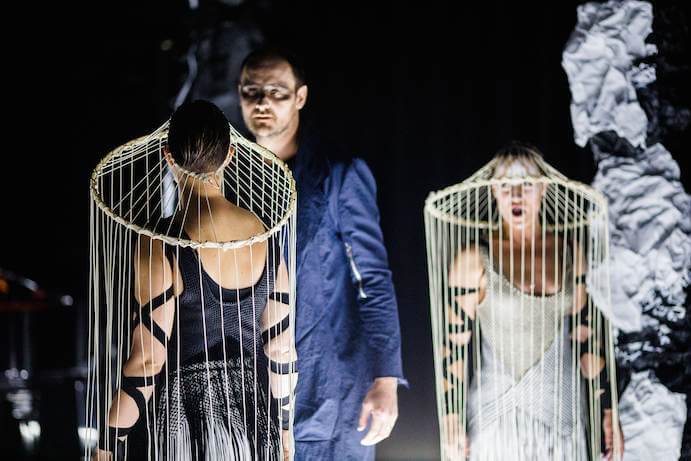In Argentinian composer Esteban Insinger’s chamber opera Hercules in Mato Grosso (2014), two men caper through the Brazilian rainforest while singing and speaking mostly in Portuguese but occasionally in German, Latin, and Quechua. His lively work was reincarnated in New York City by director Clara Cullen and producer Helena Martel Seward last month. Hercules in Mato Grosso was presented on May 20, 2015 at Dixon Place by the Americas Society, whose musical director Sebastián Zubieta conducted it both at Dixon Place and in its première last year at the Centro de Experimentación del Teatro Colón. The libretto by Pola Oloixarac is based on Hercules Florence’s journals, which document his scientific expedition to the Amazon alongside Baron Georg Heinrich von Langsdorff, a physician and naturalist. Florence is known for coining the term “photographie” (“painting with light”) upon his discovery of the pinhole camera. Throughout the years 1826 to 1829 he, Langsdorff, and a group of others traveled across South America, battling disease and various forms of unexpected unpleasantness. Insinger’s and Oloixarac’s fictionalized version deals in matters more obscure, using snakes and veils to symbolize the play of light and darkness, of mystery and clarity, in the photographer’s escapades.

Esteban Insinger
The first two acts, in which the explorers shipwrecked and a feverish Langsdorff (baritone Alejandro Spies) tried to explain his hallucinations to Hercules (tenor Peter Tantsits), took place in relative darkness. But the third and final act was almost blinding in its illumination by glowing ropes and wires representing the anacondas that had led to Langsdorff’s deluded downfall despite Hercules’s efforts to save him. Through all of the action, Luna Paiva’s stark sets, consisting of three rock columns, stood in a row across the stage, with occasional patterns of white light trickling up and down the geometric towers–a neat feature of Sarah Lurie’s skillful lighting design. Visually, the opera accomplished what most small-scale (and large-scale, for that matter) opera productions find so difficult, using simple yet abstract concepts to effectively depict the story and music without distracting or condescending.
Tantsits and Spies were similarly effective in conveying the philosophical hilarity and humor, singing and speaking long-winded jokes about Kant one moment and then the next belting out theories of appearance and disappearance. The only weaker vocal passages came during the second act’s high-pitched sections, but otherwise the two men navigated the score with dramatic believability and lyric ease. Their full, impassioned singing as they roamed in between the trio of rock columns was matched by offstage whispering and hissing by sopranos Sarah Brailey and Alice Teyssier as the anacondas. Before eventually taking the stage during the third act, the two women were an eerie, bewildering presence, felt but not seen, just like the occasional electronic track blowing gusts of wind and digital blustering across the soundscape. Finally they slithered out into the flickering lights of the third act, clad in marvelously bizarre hat contraptions, and wound the still-hallucinating Langsdorff up in bright coils, hissing all the while. The anacondas’ final passage was sung in darkness once again; the final explanatory texts appeared silently on the super-title screen, wryly explaining the reality of Hercules’s fate and eventual demise.

Sarah Brailey, Alejandro Spies, and Alice Teyssier in Hercules in Mato Grosso –Photo by James Watson for Roey Yohai Photography
Running under and over this musical and narrative trajectory were the pianists, Taka Kigawa and Leandro Rodríguez Jáuregui, the most impressive aspect of the production. Tucked away on either side of the stage along with the sopranos, their parts were coordinated fairly miraculously considering they probably couldn’t see each other very well. The pianistic interludes, sometimes motoric and sometimes staccato pointillistic hopping, rattled like bones, the perfect sonic counterpoint to the visual immovability of the rocks. Kigawa and Rodríguez Jáuregui acted as catalysts for the rapidly shifting changes in mood and theme, breaking in with twinkling spunky dissonances and rumbling low chord passages. Considering how eccentric the story of Insinger’s opera is, and how erratic the changes in tone and language, the piano parts offered a coherent yet still unpredictable element, anchoring the onstage babbling with their offstage rattling. The opera came across on first listen as above all a musical conquest, a successful expedition in the hands of Zubieta and the six talented musicians he was directing.






















